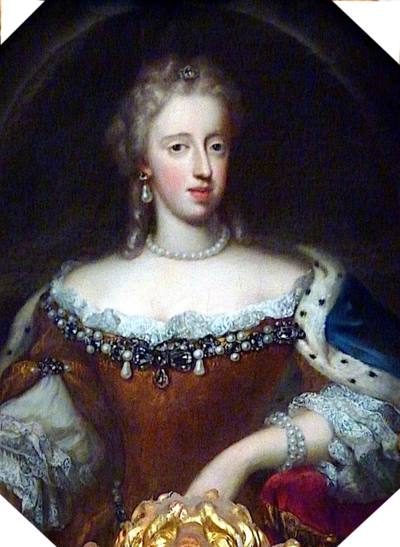
Search
Maria Antonia of Austria

Maria Antonia Josepha Benedicta Rosalia Petronella of Austria (18 January 1669 – 24 December 1692) was an Electress of Bavaria as the wife of Maximilian II Emanuel, Elector of Bavaria. She was the eldest daughter and only surviving child of Leopold I, Holy Roman Emperor and his first wife Margaret Theresa of Spain. She was the heiress to the Spanish throne after her maternal uncle Charles II of Spain from 1673 until her death.
Life
Early life
Archduchess Maria Antonia of Austria was born on 18 January 1669 in Vienna, Archduchy of Austria, Holy Roman Empire. She was the second child of Leopold I, Holy Roman Emperor (1640–1705) and his wife Margaret Theresa of Spain (1651–1673). Her only older sibling had already died by the time she was born. She had 2 younger siblings, both of whom died in infancy, and twelve half-siblings, eight of whom lived into adulthood.
Maria Antonia had the highest coefficient of inbreeding in the House of Habsburg, 0.3053: her father was her mother's maternal uncle and paternal first cousin once removed, and her maternal grandparents were also uncle and niece. Her coefficient was higher than that of a child born to a parent and offspring, or brother and sister.
Since her childhood, Maria Antonia was an intelligent and cultivated girl, sharing her parents' passion for music.
The last Habsburg king of Spain, Charles II, never fathered any children, due to his severe deformities and illnesses. According to the laws of succession in Spain, Maria Antonia would have had the right to inherit the crown had she lived long enough, because she was the only surviving child of Empress Margaret Theresa, Charles II's sister. During her childhood, it was decided that she would marry her maternal uncle, Charles II, but this plan came to nothing due to political circumstances.
As an alternative, she became a candidate for marriage to Victor Amadeus II, the Duke of Savoy, but nothing came of these plans either.
Electress
Maria Antonia finally married Maximilian II, the Elector of Bavaria, on 15 July 1685 in Vienna. The marriage between an heiress of the Spanish throne, in Maria Anna of Austria, Queen of Spain's view, gave the Bavarian Wittelsbachs the closer place in succession to the Crown than the Austrian Habsburg. Mariana's dynastic loyalty was to her daughter Margaret Theresa of Spain's descentdants, which were her granddaughter Maria Antonia and her family. This put her at odds with her younger brother Leopold I, who wanted his son to be the heir instead of Maria Antonia, his daughter. In an attempt to strengthen the claim of his son, Emperor Leopold I had his daughter to waive her inheritance rights shortly after her marriage. In exchange, he promised to have his son-in-law appointed as governor of the Spanish Netherlands.
The marriage was very unhappy, as the extroverted Maximilian and the introverted and serious Maria Antonia had little in common. Maria Antonia was reportedly offended by Maximilian's constant infidelity. When he was appointed governor of the Spanish Netherlands and left for Brussels in the company of his mistress Countess Canozza, Maria Antonia left for her father in Vienna to give birth, and it was widely assumed that she did not intend to return to Maximilian. She died of postpartum infections after childbirth.
As the niece of Charles II of Spain, Maria Antonia was of great relevance in connection with the succession to the Spanish throne, which was a major political issue in late 17th-century Europe. One of her sons, Joseph Ferdinand, was of central importance to European politics at the end of the seventeenth century as a claimant to the throne of Spain. Maria Antonia was the last of the Habsburg line in that country and Joseph Ferdinand's death before that of Charles II, the last Habsburg king of Spain, helped to trigger the War of the Spanish Succession. If he had survived Charles, the European powers might have permitted him to accede to the throne of Spain under the terms of the Treaty of The Hague (1698).
Issue
- Leopold Ferdinand of Bavaria (22 May 1689) died at birth.
- Anton of Bavaria (19 November 1690) died at birth.
- Joseph Ferdinand of Bavaria (28 October 1692 – 6 February 1699), died in childhood.
Ancestors
References
Bibliography
- Friedrich Weissensteiner: Liebeshimmel und Ehehöllen - Heyne Taschenbuchverlag 1999 - ISBN 3-453-17853-X
- Frey, Linda; Frey, Marsha (1983). A Question of Empire: Leopold I and the War of Spanish Succession, 1701–1705. New York: Columbia University Press. pp. 6, 13, 14. ISBN 0-88033-038-4.
- Langdon-Davies, John (1963). Carlos: The King Who Would Not Die. Englewood Cliffs, NJ: Prentice Hall.
- Mitchell, Silvia Z. (2013). Mariana of Austria and Imperial Spain: Court, Dynastic, and International Politics in Seventeenth-Century Europe (Doctor of Philosophy (PhD) thesis). Retrieved 21 November 2023.
- Mitchell, Silvia Z. (2019-05-30). Queen, Mother, and Stateswoman: Mariana of Austria and the Government of Spain. Penn State Press. ISBN 978-0-271-08412-1.
- Spielman, John Philip (1977). Leopold I. London: Thames and Hudson.
- Wheatcroft, Andrew (1996). The Habsburgs: Embodying Empire. London: Penguin Books. Retrieved 21 November 2023.
Text submitted to CC-BY-SA license. Source: Maria Antonia of Austria by Wikipedia (Historical)
Articles connexes
- Marie Antoinette
- Archduchess Maria Antonia of Austria (1899–1977)
- Maria Antonia
- Maria Josepha of Austria
- Archduchess Maria Josepha of Austria
- Princess Maria Antonia of Naples and Sicily
- Maria Josepha of Saxony, Dauphine of France
- Archduchess Maria Isabella of Austria
- Maria Anna of Austria
- Princess Maria Antonia of the Two Sicilies
- Joseph Ferdinand of Bavaria
- Maria Theresa
- Infanta Maria Antónia of Portugal
- Maria Amalia, Duchess of Parma
- Archduchess Maria Elisabeth of Austria (born 1743)
- Archduchess Maria Johanna Gabriela of Austria
- Princess Maria Antonia Koháry of Csábrág and Szitnya
- Maria Theresa of Savoy
- Maria Antonia Ferdinanda of Spain
- María Teresa Rafaela of Spain
Owlapps.net - since 2012 - Les chouettes applications du hibou


